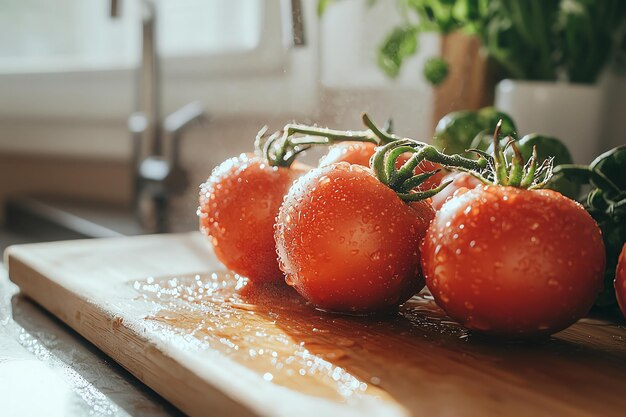Should You Refrigerate Tomatoes? Unpacking the Great Tomato Debate
Picture this: you're in your kitchen unloading groceries. You stare at a perfectly ripe, juicy tomato and wonder, "Should this go in the refrigerator?" It's a common conundrum with a surprisingly complex answer. Let's dive deep into this juicy debate and explore whether refrigerating tomatoes is the right call.
🍅 The Tomato Dilemma: To Refrigerate or Not?
Tomatoes are a staple in many cuisines, celebrated for their vibrant flavor and versatility. Whether you're making a fresh salad, cooking up marinara sauce, or simply slicing one to put on a sandwich, the quality of your tomato can make all the difference. But what's the best way to store them to maintain their flavor and texture?
Understanding Tomatoes: A Quick Biology Lesson
Tomatoes are fruits, although culinarily treated as vegetables. They grow best in warm climates and develop their full flavor when ripened in natural conditions. Upon reaching maturity, tomatoes produce a high amount of ethylene—a natural gas that aids in the ripening process.
Why Refrigeration Is Controversial
When it comes to refrigerating tomatoes, here's the crux: Refrigeration can halt the ripening process and negatively affect flavor and texture. Tomatoes contain compounds that contribute to their flavor, which can degrade at temperatures below 50°F (about 10°C). Therefore, refrigerating them can lead to a mealy texture and a less robust taste.
Counter-Argument: Keeping Them Fresh
On the flip side, refrigeration can help extend the shelf life of tomatoes, especially if they're already perfectly ripe. Without refrigeration, ripe tomatoes can spoil quickly, especially in warm, humid environments.
🥫 When To Refrigerate Tomatoes
Here's a practical rundown for when refrigeration might be the better option:
- Ripe Tomatoes: If you have fully ripe tomatoes and you're not using them within a day or two, refrigeration can help keep them from spoiling.
- Overripe Tomatoes: These are best stored in the fridge to prevent them from going bad.
- Cut Tomatoes: Once a tomato is cut, refrigerate it in an airtight container to maintain freshness and prevent bacterial growth.
🌿 Storing Tomatoes Without Refrigeration
For tomatoes that are not yet fully ripe, room temperature is ideal. Here's how to do it right:
- Place Them Stem Side Down: This can prevent moisture from entering the fruit and hasten spoilage.
- Avoid Exposing to Direct Sunlight: A cool, shaded spot is best.
- Use a Single Layer: Avoid stacking tomatoes to reduce the risk of bruising and promote even ripening.
🍽️ Culinary Considerations: Preserving Flavor and Texture
Bringing Flavor Back
If refrigeration was necessary, there's a trick that might help bring back some flavors. Let refrigerated tomatoes sit at room temperature for a day or two before consumption. This allows them to regain some taste and aroma.
Cooking with Refrigerated Tomatoes
When using refrigerated tomatoes in dishes where texture is less of a concern, like soups or sauces, any loss in quality might be less noticeable. Cooking tends to blend flavors, which can compensate for any changes caused by refrigeration.
🍋 Related Subtopics: Expanding Your Refrigerator Knowledge
As we navigate the world of tomatoes and refrigeration, consider these related topics that may pique your interest:
How Different Fruits and Vegetables React to Refrigeration
- Bananas: Similar to tomatoes, refrigeration can affect both flavor and color.
- Potatoes: Prefer cool, dark, and dry places; refrigeration can turn starch into sugar.
- Cucumbers: Best at room temperature but can be refrigerated to extend shelf life.
Exploring Ethylene Gas and Its Effects
Understanding which fruits produce ethylene and how this affects storage can help you make informed decisions about your entire produce basket.
Ethylene-Producing Fruits:
- Apples
- Bananas
- Peaches
The Benefits of a Root Cellar
Explore traditional methods of food preservation that rely on cool, consistent temperatures but without the cold bite of modern refrigeration.
🌟 Key Takeaways: A Tomato Storage Guide
Here's a quick-reference list to help you make informed decisions on tomato storage:
- Ripe Tomatoes: Refrigerate if not using soon; use the naturally warmed technique to revive flavor.
- Unripe Tomatoes: Store at room temperature away from direct sunlight.
- Overripe or Cut Tomatoes: Always refrigerate to prevent rapid spoilage.
- Cooking with Refrigerated Tomatoes: Use in cooked dishes for minimal impact on flavor.
By understanding the unique characteristics of tomatoes, you can make the most of this delicious fruit in all your culinary adventures. Whether you're a home cook or just a tomato lover, these insights equip you to keep your tomatoes tasting their best. So next time you unload your groceries, you'll know just what to do.
